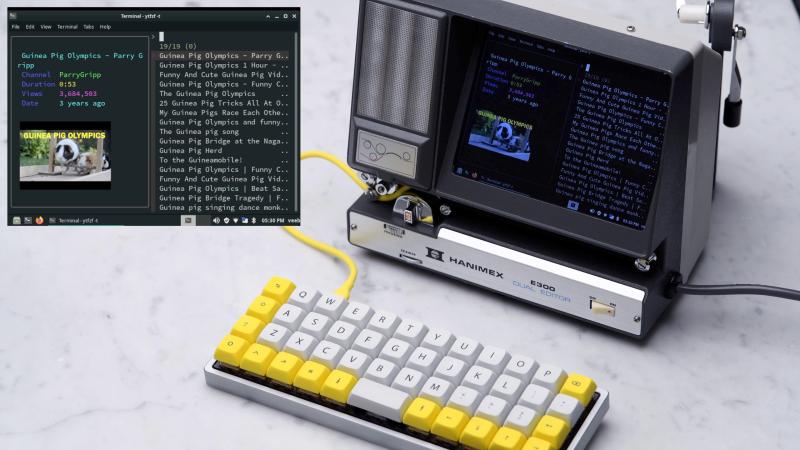We love hacks that give new life to old gadgets, and [edwardianpug]’s YouTube Terminal certainly fits the bill by putting new hardware inside a Super 8 film editor.
[edwardianpug] could have relegated this classy-looking piece of A/V history to a shelf for display, but instead she decided to refresh its components so it could display any YouTube video instead of just one strip of film at a time. The Boost-Box keeps the retrofuturistic theme going by using the terminal to search for and play videos via Ytfzf.
The original screen has been replaced by an 800×600 LCD, and the yellow USB cord gives a nice splash of color to connect the ortholinear keyboard to the device. Lest you think that this “ruined” a working piece of retro-tech, [edwardianpug] says that 20 minutes would get this device back to watching old movies.
Are you looking for more modern and retro mashups? Check out these Dice Towers Built In Beautiful Retro Cases, a Vacuum Tube and Microcontroller Ham Transmitter, or this Cyberdeck in a Retro Speaker.
















“Lest you think that this “ruined” a working piece of retro-tech, [edwardianpug] says that 20 minutes would get this device back to watching old movies”
FYI there’s currently 24 film editors listed on the Goodwill auction site. Perhaps the one edwardianpug modified is particularly rare or valuable, but as a species old film editor sets don’t seem to be very scarce.
Still its nice to not destroy the original functionality permanently if you can avoid it. Oneday they might actually be super rare, valuable and maybe even useful!
Still wouldn’t stop me from gutting and modifying in a destructive style if the changes I want need it, no point leaving old tech sitting on a shelf to rot.
I have no qualms with destructively modifying these either, I see them all the time in even local thrift shops
As it is with old architecture: If there’s many examples of a style, they don’t need to be protected, until we tear done one too many and they’re (almost all gone) at which time we should’ve protected them years ago.
Not all old architecture should be preserved, except as a warning to future generations that this is a stupid idea I suppose…
My dad has 2 of them in his garage right now, and the newest film he shot is from the early 70’s and I doubt we will be editing that anytime soon
The design of even simple film playback machines could be ingenious.
In the 1980s I used a simple hand-cranked Super-8 editor that my parents had gotten in the late 1960s. The only thing powered was the light bulb. Now because film displays separate frames, you normally can’t just run the film past the display head like with cassette tape. The normal mechanism is a pull-down gearing that “holds” the film in place for a bit then moves it quickly past (while light is dimmed). This didn’t do that–the film would go straight past the head as fast or slow as you cranked it, and no light shutter. Turns out there was a square prism above the film that would rotate along with the film frame, so the frame was “held” optically until the square rotated a new face in time for the next frame. Neat. It wasn’t the best optical quality, but for editing who needs that?
(The thing that did give me fits was the projection bulb itself, which may have been as old as the editor. I think there was a filament loose in it–if you put on a table normally, the bulb would “fizzt!” and go out. But if I tilted the unit back slightly with a book, the bulb would stay on. The bulb was a custom one soldered to a metal mount, which discouraged a kid like me from ordering a replacement.)
That sort of continuous-film-rotating-prism mechanism was used for other optical systems. For example, high-speed film cameras (e.g. Fastax) use a spinning prism and continuous film movement to allow for very high framerates: https://youtu.be/_9ojjFyO8Po?t=201
My father got an editor. We had a movie camera and some external lights. And it was only used for a few years. The editor was only used to view things, maybe slice rolls together. Never editing.
If a Pi camera and suitable optics could be shoehorned in there, the editor would edit films once again _and_ be a Pi terminal. Probably a super 8mm capture device at the same time, which could be quite the upgrade.
I asked my super8 friends about doing this but they thought it was a waste of time. I. However think you are onto something here.
“new life to old gadgets” – I seem to be encountering innumerable, very stylish automatic coffee machines, in my travels. They’re all discarded, ‘planned obsolescence’, mass consumer appliances, yet the case they come in is a work of industrial art. Dunno what to build into one, but once I do…
“Replace the screen with an LCD”
Bah. Couldn’t they have used some kind of projector to retain the vintage aesthetic. This is barely a mode, just using a vintage device as a case.
I love seeing all the Guinea Pig videos.